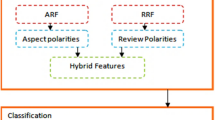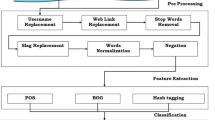Abstract
The role of social networks has bought a tremendous change in the analysis of the opinions. Understanding people sentiments or opinion helps the business or organization to better understand their customers. There are several platforms where people can easily post their views about a service or products, these can be facebook, twitter e.t.c. Feature extraction or aspect extraction becomes important since one needs to know the qualities a product or a service have. In this research, we have analyzed hotel reviews by applying n-gram for feature. As the dataset is always noisy so basic preprocessing steps are applied before extraction. The features extracted are trained and tested by basic machine learning classifiers. Various machine learning algorithms like KNN, SVM, and random forest are used for the analysis of the performance. The evaluation measures are calculated at the end to validate the results. K-fold cross validation scheme is also applied on the dataset to improve the overall accuracy of the results.
Access this chapter
Tax calculation will be finalised at checkout
Purchases are for personal use only
Similar content being viewed by others
References
Pang, B., Lee, L., Vaithyanathan, S.: Sentiment classification using machine learning techniques. In: Proceedings of the Conference on Empirical Methods in Natural Language Processing, pp. 79–86 (2002)
Liu, B.: Sentiment analysis and subjectivity. In: Indurkhya, N., Damerau, F.J. (eds.) Handbook of Natural Language Processing, 2nd ed. CRC Press, Boca Raton (2010)
Cambria, E.: Affective computing and sentiment analysis. IEEE Intell. Syst. 31(2), 102–107 (2016). https://doi.org/10.1109/MIS.2016.31
Naz, S., Sharan, A., Malik, N.: Sentiment classification on Twitter data using support vector machine. In: Proceedings of IEEE/WIC/ACM International Conference on Web Intelligence (WI), Santiago, Chile, December 2018, pp. 3–6 (2018). https://doi.org/10.1109/WI.2018.00-13
Sarkar, K.: Using character N-gram features and multinomial Naïve Bayes for sentiment polarity detection in Bengali tweets. In: Proceedings of 5th International Conference on Emerging Applications of Information Technology (EAIT), Kolkata, India, January 2018, pp. 12–13 (2018). https://doi.org/10.1109/EAIT.2018.8470415
Zhou, L., Bian, X.: Improved text sentiment classification method based on BiGRU-attention. J. Phys. Conf. Ser. 1345, 032097 (2019)
Jianqiang, Z., Xiaolin, G.: Comparison Research on text pre-processing methods. In: IEEE Access, vol 5 (2017). https://doi.org/10.1109/ACCESS.2017.2672677
Yoon, H.G., Kim, H., Kim, C.O., Song, M.: Opinion polarity detection in Twitter data combining shrinkage regression and topic modeling. J. Informetrics 10(2), 634–644 (2016)
Pandey, S.V., Deorankar, A.V.: A study of sentiment analysis task and it's challenges. In: 2019 IEEE International Conference on Electrical, Computer and Communication Technologies (ICECCT), pp. 1–5 (2019). https://doi.org/10.1109/ICECCT.2019.8869160
Subramanian, R.R., Akshith, N., Murthy, G.N., Vikas, M., Amara, S., Balaji, K.: A survey on sentiment analysis. In: 2021 11th International Conference on Cloud Computing, Data Science & Engineering (Confluence), pp. 70–75 (2021). https://doi.org/10.1109/Confluence51648.2021.9377136
Amplayo, R.K., Lee, S., Song, M.: Incorporating product description to sentiment topic models for improved aspect-based sentiment analysis. Inf. Sci. 454–455, 200–215 (2018). https://doi.org/10.1016/j.ins.2018.04.079
Author information
Authors and Affiliations
Editor information
Editors and Affiliations
Rights and permissions
Copyright information
© 2022 Springer Nature Switzerland AG
About this paper
Cite this paper
Vaish, N., Goel, N., Gupta, G. (2022). Feature Extraction and Sentiment Analysis Using Machine Learning. In: Dev, A., Agrawal, S.S., Sharma, A. (eds) Artificial Intelligence and Speech Technology. AIST 2021. Communications in Computer and Information Science, vol 1546. Springer, Cham. https://doi.org/10.1007/978-3-030-95711-7_11
Download citation
DOI: https://doi.org/10.1007/978-3-030-95711-7_11
Published:
Publisher Name: Springer, Cham
Print ISBN: 978-3-030-95710-0
Online ISBN: 978-3-030-95711-7
eBook Packages: Computer ScienceComputer Science (R0)




